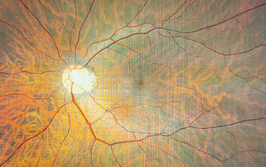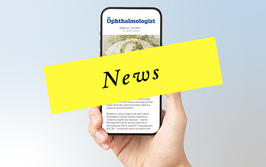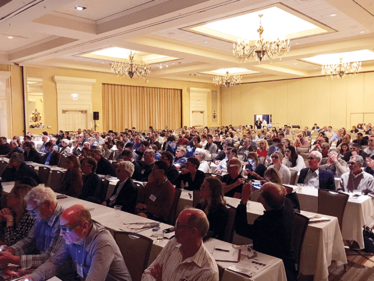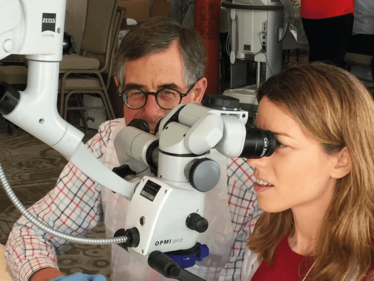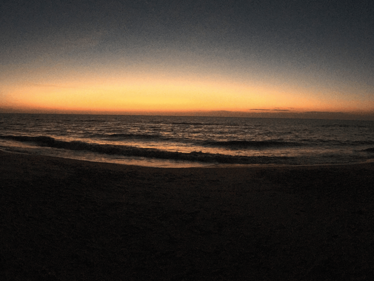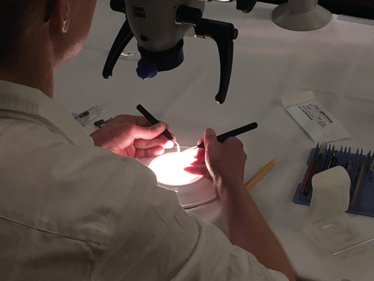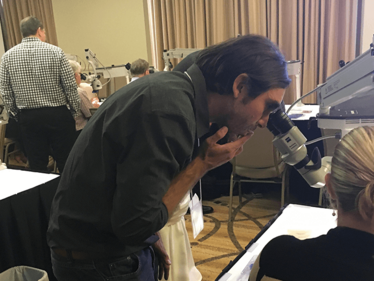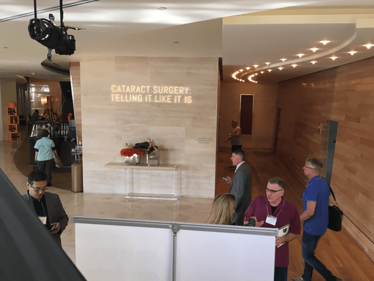Straight Talking
Why Robert Osher decided to start his own meeting, Cataract Surgery: Telling It Like It Is, plus what’s on offer, and how he runs it
At a Glance
- What would make one man want to set up his own annual cataract meeting?
- Would surgeons come to a meeting which would provide cutting-edge technique and technology but would not offer CME? That was the question that would make or break the meeting.
- A huge financial risk and significant time commitment collided with a need to keep his finger on the pulse of what cataract surgeons wanted to see.
- From ‘marathoning’ the faculty to subsidizing the residents, Osher explains his approach to running the meeting.
A cataract surgery meeting. No CME (continuing medical education). He bears all the financial risks of running it himself. Apparently, when told of his plans, Dick Mackool told him: “You’re crazy! There’s no possibility that a meeting like this would ever succeed; people come for credit.” The man is Robert Osher. The meeting is Cataract Surgery: Telling It Like It Is!
Busy practice. Ophthalmology professor. Globetrotting lecturer. You have enough on your plate. Why do this?
Why? The story is entertaining. At the time, I had chaired the cataract section of the Hawaii winter meeting for over 20 years. Every year, I would put on a symposium and the topic would vary based on what the organizers asked for, and they gave me free rein. But then an educational company was brought in to oversee the winter meeting – and I received a pink slip in the mail, which said: “You are suspended for one year because you violated the CME guidelines.” I wrote back and explained that I didn’t even know there were CME guidelines! Their response was: “Well, they’re new.” I asked them what they were and what I’d done wrong. The response: “You’re not allowed to mention product names.”
To me, this was ridiculous – especially as the organizers had assigned to me the topic of new products in cataract surgery... Did you want me to pantomime the topic? I have to mention the names! “We have a zero-tolerance policy.”
In my final reply, I noted a similar symposium I give each year at AAO – “The Cutting Edge” – which covers all things new. “It’s one of the largest symposia of the meeting, and the AAO is a careful, extremely professional organization,” I wrote. “They’ve never had a problem with this – and you’re telling me I’m suspended for one year? I refuse to accept the suspension, rather, I insist on a lifetime ban; I will start my own meeting to teach the way teaching is meant to be!”
Why did you feel so strongly about this?
I travel over 100,000 miles a year giving lectures and teaching surgeons. I know how to teach. I know how people want to learn – and it’s not by restricting information. It’s by honest, candid, unrestricted communication.
How did you start?
I went to the surgeons that were the most experienced at cutting-edge off-label procedures; the surgeons with the most confident, rebellious and passionate personalities. I had a simple message: let’s start a meeting with no CME. Dick Mackool told me I was crazy and that people want to attend for credits. We didn’t need those people. We hoped to attract the people who come to learn and really want to raise their game. The most contemporary beneficial procedures for their patients is what they really care about.
How do you choose what’s on the program?
Right from the start, I implemented a detailed evaluation survey from both physicians and exhibitors, so I could learn what people do and don’t like. I take the time to read and really understand the feedback – and doing so has been invaluable for the development of the meeting. I change the agenda dramatically from year to year. What people didn’t like, I put in red; what people liked, I put in blue. New suggestions were circled in green. I decided that I would try to aim the meeting content at three different levels: one for young surgeons – primarily enthusiastic, yet not very experienced; one for the routine ophthalmologist, who is striving to make his or her practice better; and one for advanced surgeons – I figured I had Ike Ahmed, Mike Snyder and Dick Mackool operating on the most challenging cases in North America, so I had that covered.
We’re not afraid to take gambles on new concepts, but we do have the symposia that always work – preoperative challenging cases, for example. I show the routine mature cataract, the white cataract, the posterior polar cataract, the miotic pupil, Flomax, nanophthalmos, extreme myopia... And then we have the Mike and Ike show: they take the symposium to the extremes, managing the most extraordinary, unusually difficult, challenging cases, so people can see what’s possible. The presentations progress from the basic, to the intermediate, to the advanced – and everybody stands to benefit.
Is it purely limited to cataract surgery?
No. As the meeting grew over the years, I decided to add subspecialty updates for physicians who wanted to come early (for no extra charge) on the day before the meeting – neuro, uveitis, oncology, refractive, plastics, retina, glaucoma and cornea and more. Then the wet labs were introduced. We started with two – on how to do anterior vitrectomy through the pars plana (which was a scary proposition at the time), and how to use intracameral devices. Later, I brought in Boris Malyugin to teach his ring, and Graham Barrett to discuss IOL calculation. This meeting now offers over 30 wet labs – for example, Ike Ahmed oversees six different glaucoma wet labs, one on each MIGS device. There are many other different courses like intrascleral haptic fixation and iris reconstruction – there’s a whole smörgåsbord of opportunity to learn in a didactic environment (in the main hall) or in the private setting of these afternoon wet labs.
It’s the same with Warren Hill: we run through 40 or 50 different situations where IOL selection is challenging – from the most basic like monovision (how safe can you be?) all the way to those extreme situations, where you’re exchanging lenses and considering power ratios, depending on the strength of the lens; there’s so much to cover. Fortunately, despite being the world’s expert – bar none – Warren Hill is so generous and kind with his time. And that’s another reason why this meeting is unique. The faculty interaction is invaluable, especially in the evening when there is plenty of Q&A.
If you’re doing it yourself, what risks are you exposed to?
Boy, is there an astronomical financial risk! The cost of the last meeting was well over a million dollars. I have to give the venue my credit card, guarantee that several hotels will be booked, and commit to a certain amount of food and beverage. Then there is the cost of AV, security, promotion, programs, signs, staff – I get dizzy just thinking about the expenses.
Another reason for the high cost is my belief that the faculty deserves honoraria; I want to compensate them for their time away from their practices, of course, but I also expect so much more from them. I work them to death! I want to maintain the intimate environment of a small meeting, so the faculty must be there for the delegates to meet and question. I also believe in giving the attendee more than expected by ‘marathoning;’ we’re not afraid to go from 7 in the morning until 10 or 11 at night – and the faculty buy in to these informal yet highly informative late night sessions.
Despite the high costs, this is a champagne meeting on a shoestring budget – early bird registration is only $675, and if you want to attend a US winter meeting, this is great value. The hotels next year in Amelia Island will be between $200–$300 a night, depending on whether you stay in the Omni or the Ritz-Carlton. And I actually subsidize residents’ registration fees so that they can attend, even on meager salaries (last year, subsidies ran to $42,000). Practicing Ophthalmologists and trainees can register on the meeting website cstellingitlikeitis.com.
How do you make the numbers work?
Exhibitors. Last year we had over 100. They provide breakfast, lunch, and dinner for all of the surgeons (and the exhibitors), and they also make the attendance price very low. We’re not about making profit – we’re all about educating as many people as possible.
What does it take to plan and run the meeting?
Running a meeting takes an egregious amount of time. I spent a whole weekend on my hands and knees at the venue for the next meeting (often until 4:30 am), mapping more than hundred exhibitor booths and assigning all the wet labs to different rooms. I met with the security team, the chefs, and the housing director. I went on a tour of the beaches, the golf courses, the hotel’s gym – everything. My approach to it all is quite simple: I expect nothing less than perfection. It’s the same with the A/V team; I tell them that I will pay well but there are to be no glitches – and that means preparing three or four months ahead of time. We can’t risk an A/V crash because every moment of the meeting is scheduled down to the minute.
It’s surprising just how much time and effort are required. And it must be crammed into a busy surgical practice, a demanding lecture schedule, the regular commitments of a professor of ophthalmology, my video journal, research, and 8 grandchildren.
It can’t be just you organizing it, right?
I’m pleased to say it isn’t just me organizing the conference; I have an amazing partner in this: Debbie Osborn – a real dynamo. She runs five medical societies in Connecticut and is involved with the best ophthalmology meetings in the country. She also lobbies to protect medicine in the General Assembly. I turn to Debbie when I run into a situation that I simply can’t deal with. It’s nice to be able to call up a person with the same commitment to the cause, in terms of energy and dedication, who can help resolve some of the issues we encounter. After all, I never learned this stuff in medical school! Debbie always reminds me that it’s all about quality; we have a purpose and a mission, and we must stick to it.
Keynote Speakers. Who is next year’s?
Over the years, I’ve brought in top international surgeons who have developed their own innovations – and we give them recognition for what they have achieved. I have picked some of the best surgeons on the planet and recognized them with a named lecture in their honor, so that others could see and meet Doug Koch, Boris Malyugin, Graham Barrett, Abhay Vasavada, Fernando Trindade, and Richard Packard. Next year, we’re recognizing Ehud Assia. We are also honoring Sam Masket and Alan Crandall for their wonderful careers.
What is the most important aspect of the meeting for you?
I still insist on retaining that intimate feeling where a surgeon can come up and ask a question – and where the teacher feels like it is a privilege to share his experience. It’s not an imposition, rather it’s a pleasure to help that surgeon. Our meeting is educational, and everything that is presented and discussed is ultimately about helping the ophthalmologist do her or his job better – and that ultimately benefits their patients too. Our mission is to send each attendee home as a more knowledgeable and confident surgeon.
Robert Osher is Professor of Ophthalmology at the University of Cincinnati College of Medicine; Medical Director Emeritus of Cincinnati Eye Institute; Editor of the Video Journal of Cataract & Refractive Surgery; and the organizer of Cataract Surgery: Telling it Like it is! For more information about the meeting, please visit cstellingitlikeitis.com
Robert Osher is Professor of Ophthalmology at the University of Cincinnati College of Medicine; Medical Director Emeritus of Cincinnati Eye Institute; Editor of the Video Journal of Cataract & Refractive Surgery; and the organizer of Cataract Surgery: Telling it Like it is! For more information about the meeting, please visit cstellingitlikeitis.com.
